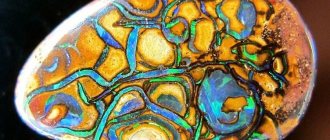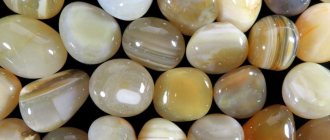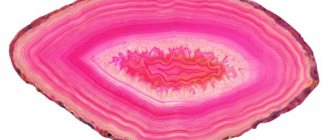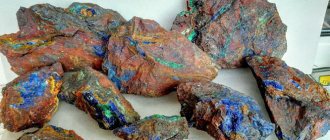Garnet is a stone as ancient as it is covered in legends. There were legends about the magical properties of pomegranate in all the places where this stone was found. Its habitat is very wide: there are deposits in Asia, Europe, Africa and even America. Due to the fact that certain types of garnet come to the surface in the form of placers, many ancient peoples had the opportunity to become acquainted with them.
History and origin
It is impossible to tell the full story of the pomegranate briefly, it is too voluminous. A description of the stone is found in the records of medieval scribes from Europe, Persia and Arabia. It is found in gold jewelry of ancient Scythia; the inhabitants of ancient Rome were familiar with it, who gave the stone the name “carbuncle” and their neighbors, the Hellenes, who called it “anfrax”.
Garnet stone
The ancient Greeks most often worked with the dark variety of garnet. The name "anfrax" means "coal". At the same time, the ancients often called all minerals of red color, corresponding structure and transparency, garnet.
Noble spinel, some varieties of hyacinth and other scarlet or crimson crystals were confused with garnet (or, more precisely, they were not distinguished from it).
True, garnet has always been contrasted with ruby, which is harder and has a different, more perfect play of color. It began to be considered a true precious stone only in the 17th century; before that it had rather a utilitarian meaning. Ancient people valued the medicinal properties of the gem more, in particular the ability attributed to it to stop bleeding.
In Europe and the Middle East, mainly the red variety of stone was mined, two subspecies of which were later called pyrope and almandine. The mineral received its modern name thanks to the “Phoenician apple” - the pomegranate fruit tree, for the characteristic garnet color of its crystals. The word “granatus” itself means “grain-like” - referring to the dark red translucent grains of this plant. Only at the beginning of the Renaissance did scientists discover that garnets can be pink, purple, yellowish, colorless, and even black or green; the latter are sometimes confused with chrysolite.
In medieval Rus', this stone was called “bechet” or “venisa”, sometimes “worm” or “wormy yacht”.
In a dark palette
The winter color type is very capricious. Despite the fact that the skin is fair and the eyes are bright and expressive, the wrong hair color can ruin the whole picture. With an appearance of this type, alas, all of the above shades will look ridiculous and inharmonious. But it cannot be that a woman who has very bright facial features cannot afford garnet hair color. The colors from this palette are partially applied to dark hair, and this work is based on one of the modern dyeing techniques. As a result, the hair remains either dark brown or black, and at the same time there are curls in it, colored in the color of a precious ruby.
Physicochemical characteristics
From the point of view of physicists, chemists and geologists, all minerals of the garnet family have a complex molecular structure. The basis is silicon oxide in combination with various metals - mainly iron, manganese, magnesium, and less often aluminum and chromium. A separate group of garnets contains calcium and metal compounds.
The color of the crystal depends on the metal impurities. Iron gives a red color, manganese gives a yellowish color, aluminum lightens the color, and an admixture of titanium makes it black. Calcium garnets are mostly yellow or green.
Differences in the chemical composition have little effect on the properties of pomegranate; they are approximately similar in all types. This stone has a hardness of up to 7.5 Mohs, a vitreous luster and a medium density.
Garnet stones
| Formula | X3Y2Z3φ12, where X are elements in the dodecahedral position; Y – elements in octahedral position; Z – elements in tetrahedral position; φ – O, OH or F |
| Color | Very rarely colorless; mostly painted in different colors, with the exception of blue |
| Shine | Glass, greasy, resin, diamond |
| Transparency | Transparent, translucent, see-through |
| Hardness | 6 6,5 7 7,5 |
| Cleavage | Not visible |
| Kink | Conchoidal, uneven |
| Density | 3,4 — 4,3 |
Classification and description of pomegranate
Iran (Persia) is considered the historical homeland of the plant, but today the culture is spread across different regions. Among them:
- Georgia;
- India;
- Tajikistan;
- Iran;
- Israel;
- Greece;
- Uzbekistan;
- Afghanistan and others.
On the territory of Russia, pomegranate is cultivated in Dagestan (southern regions), on the Black Sea coast, and in Crimea.
This is interesting! According to botanical terminology, pomegranate fruits are scientifically called “pomegranates.”
May be interesting How to grow pomegranate in open ground and care for it Varieties and varieties of pomegranate with descriptions and photos How to properly propagate pomegranate at home
The pomegranate tree is a representative of the Derbennikov family; two species are classified in the genus. One of them is the famous common pomegranate, the other is the Socotran pomegranate.
The second species grows only on the island of Socotra (Yemen), is endemic, and is not suitable for industrial cultivation.
The varieties and varieties bred by breeders are derivatives of the common pomegranate. There are about 500 varieties of pomegranate in nature, including cultivated species with sweet, sour, and tart fruits. Trees or shrubs reach a height of 3-5 meters, decorative species do not exceed 0.8-1 meters. Flowering and fruiting depend on the place where the fruit grows: in the Northern Hemisphere, the season begins at the end of summer and lasts until February, in the Southern Hemisphere - from early March until May.
Pomegranate prefers illuminated places and is undemanding to the composition of the soil. It grows in subtropical climates and does not tolerate temperatures below -15ºC. In temperate climates, cultivation as an exotic plant in greenhouses is possible (but the creation of optimal conditions is required). Even frost-resistant varieties must be covered for the winter, otherwise the tree will die. In such a climate, pomegranate grows normally, but does not bloom often, and even less often bears fruit.
Pomegranate fruits contain a huge amount of useful organic acids, vitamins, and microelements. Residents of ancient Egypt, Greece, Rome, and Western Asia knew about the benefits of the fruit, considering its pulp and juice to be medicinal. In Azerbaijan, pomegranate is called the “king of fruits”, and the number of varieties grown here exceeds dozens.
Mining locations
The places where garnet is mined have different geological characteristics. Some subspecies of this mineral, for example pyrope, are mined along with diamonds, in diamondiferous rocks (kimberlite pipes). Such deposits are located in South Africa and Russian Yakutia. The most common subspecies, almandine, is found throughout the world in shale and gneiss rocks, both in the thickness of mountain ranges and in placers. Calcium garnets, such as grossular, are often found in limestone rocks.
In Russia, the largest concentrations of garnets are located on the Karelian Isthmus and on the Kola Peninsula, mainly almandines. In the Urals, a rare and beautiful uvarovite garnet is mined.
The largest garnet deposits in the world, besides our country, are located in the USA and Canada. They are found in Brazil, Madagascar, Finland, Azerbaijan and some European countries. But the gem mined there is distinguished by its unique color.
Popular varieties of pomegranate with photos and descriptions
In different countries, gardeners and farmers grow different types of crops. Depending on climatic conditions, plants with sweet and tart fruits, tall and small compact sizes are planted.
The most productive and famous varieties:
- Gilyusha (Gyuleysha) - there are two types - red and pink. Both species were bred in Azerbaijan and are distinguished by their large fruit size and good grain taste. Fruits weighing up to 400-500 g, slightly oval, burgundy in color. There are dark stripes on the skin. The grains are rich cherry color. The taste is sweet and sour, there is an aroma. The varieties are unpretentious and tolerate short-term temperature drops down to -15ºC;
- Achik-Anor - produces fruits with a slightly sour, tart taste. Bred in Uzbekistan, the trees are tall, up to 4.5-5 meters high. Ripening time is average. The fruits reach 400-450 g. The grains are large, beautiful cherry color;
- Bala-mursal is one of the sweet varieties cultivated in Azerbaijan. The fruits are small, 200-250 g, flattened, rich red-burgundy color. The taste is pleasant, sweet. 20-30 kg of crop is harvested from the tree;
- Kizil-Anor is an Uzbek variety with large, orange-red fruits. The grains are sweet and fleshy. The fruits of this pomegranate can often be seen on supermarket shelves in Russia;
- Mangulati sweet - bred in Israel. A large tree grows up to 4-5 meters, the branches are prickly. The leaves are elongated and glossy. The fruit weighs up to 200-210 g, the seeds are covered with fleshy pink-red pulp. Sweet and fragrant appearance. The seeds are used in cosmetology to make oil. Israeli-made anti-aging creams with the addition of pomegranate seed oil are in demand among women in many countries;
- Bedana - the main cultivation region is India. The bushes are powerful, well-leafed and tall (up to 4 meters). The fruits are small, with purple skin and red grains;
- Improved Kazake – tasty, with large pomegranate seeds. The peel of the fruit is carmine or cream with stripes of color, thin. The inner surface of the skin is yellow.
- Alandi is a variety from India that produces fruits that are sweet and slightly sour. Shrub up to 2-2.5 meters high, pomegranates weighing 250-300 g, with purple peel. The grains are burgundy-red with a pink tint.
Taking into account that there are a huge number of varieties and varieties of crops, you can choose a pomegranate that suits your specific requirements. Those who live in a climate unsuitable for plants grow indoor species that are highly decorative.
Colors and varieties
Classic garnets have all shades of red; this is their main distinguishing feature. Unlike ruby, the fruits of the “Phoenician apple” are not so transparent; they have a slight moiré haze. Some specimens are purple, some are black, others are distinguished by their play of green tint.
Main varieties of pomegranate:
- Pyrope. One of the few that matters in jewelry. Rich red color, closer to purple.
Pyrope stone - Almandine. The most common of all garnets. Red almandine differs from pyrope in its lighter shade, but the stone can also be purple and almost black.
Almandine stone - Spessartine is brownish, orange, sometimes yellow. Mined in Germany.
Spessartine stone - Grossular. In Latin - "gooseberry". It got its name because of its color similarity to gooseberries; it is the same greenish-brown with hints of yellow. There are grossulars of emerald shades.
Grossular stone - Uvarovite is a Ural garnet of rich emerald color.
The stone will boil down - Hessonite is the color of honey.
Hessonite stone - Andradite is a Brazilian variety of garnet. There are different colors - red, yellow, greenish.
Andradite stone - Melanitis is black.
Melanite stone - Leucogranate is a transparent stone. It is more important for industry than for jewelry.
Leucogranate stone
It is difficult to distinguish a garnet of an “unusual” color from another precious or semi-precious stone. This can only be done in the laboratory.
Artificial pomegranate
Since this stone is important for industry - from the manufacture of abrasives to the creation of laser emitters - they learned to synthesize it back in the first half of the 20th century. Artificial garnet is not a fake in the full sense of the word, since it was not originally intended for use in the jewelry industry.
Moreover, using high-quality synthetic garnets to imitate real ones is pointless: due to the nature of the production process, the price of an artificial garnet that looks similar to a natural one is comparable to the price of a natural one. But thanks to synthesis, it is possible to grow stones of any color and shade, for example, dark blue (such garnets do not occur in nature).
Synthetic stones are usually used for industrial needs. They are added as additives to mortars, used to create various elements in microelectronics, laser systems are constructed based on them, and so on.
Varieties of pomegranate with soft seeds
The varieties included in this group are often called seedless, but this is not true. The grains inside the fruit are soft and sweet, so it gives the impression of an unusual granular pulp. Bred by breeders to simplify the processes of juice production.
Known varieties:
- Mollar de Elche is a variety with pink pomegranates, with a thin, apple-like peel. Weight – 600-800 g, taste – sweet, pleasant. In Spain, this cultivar is cultivated on an industrial scale, supplying it to different countries of the world;
- Wonderful is a pomegranate bred in the USA, one of the first in the line of crops with soft grains. The bushes are low, the fruits are pinkish-cream, with a thin peel. The grains are juicy, large, with a pleasant sweet taste. There is no sourness or astringency. It is grown in industrial plantings in Israel and Peru.
Fruits with soft seeds give a good yield of juice and have a sweet taste. The agricultural technology of such varieties is standard and does not differ from the usual care of stone fruit pomegranates.
Medicinal properties
The healing properties are mainly attributed to the red varieties of this stone - pyrope and almandine, since these are the most ancient known subspecies of garnet.
Less often they talk about grossular.
The importance of garnet in lithotherapy is great, but you need to be aware that in most cases this does not mean any stones, but red ones. And their main property is based on the ancient rules of sympathetic magic. This means that like influences like - red as blood, the garnet has power over blood.
It means that:
- pomegranate can stop wound bleeding;
- it promotes accelerated regeneration;
- it normalizes blood pressure.
In addition, wearing a garnet in gold is beneficial for health as a preventive measure against colds - it prevents many pulmonary diseases. A stone set in silver is suitable for people who have weak immunity and, due to this, an increased risk of contracting a sore throat, pneumonia or other infectious diseases.
Gold ring with garnet
Pomegranate is able to give its owner vigor and vitality to cope with almost any illness or stress.
Some lithotherapists recommend wearing a gold garnet ring on the middle finger of the right hand as a way to relieve pain from frequent migraines.
Magic properties
The magical properties of the stone primarily include the ability described above to influence the blood, as well as fill its owner with energy and give strength for new achievements. No wonder rings with garnets were very popular among the crusader knights who fought in difficult and unusual conditions for Europeans.
The ancient magic of the pomegranate patronizes people who are strong, purposeful, but at the same time - the key condition - fighting for a good cause.
A person’s occupation can be anything - warrior, politician, businessman, artist. There are two key conditions: he must have a creative beginning, that is, bring something new into his activities, constantly improve and move forward, and he must not have evil, dark thoughts. Garnet is a stone of fair combat, frontal attack. He can destroy a swindler and an intriguer, lead him into a cycle of intrigues he has woven and confuse him. Often the gem brings such people to a severe mental disorder, which in the material sphere goes hand in hand with bankruptcy and ruin.
Red pomegranate helps those people who want to develop themselves and develop their business.
It is very important for the owner of this stone to have a clear, formulated goal, otherwise a “confused” stone will push the owner from side to side, in some cases even provoke diseases.
Pomegranate amulets, talismans and amulets are capable of:
- help the owner identify hidden enemies;
- heal wounds;
- protect from water hazards;
- help in love affairs, especially in winning the heart of an unapproachable girl;
- enhance the charisma and charm of the owner.
Please note: Garnet jewelry is dangerous for some people. This stone enhances the primitive nature of a person, awakens the predator, aggressor, and beast in him. In this way, it helps people suffering from a lack of aggression (in some life situations this is a minus), but those who are naturally aggressive, with a strong “beast” inside, are turned into monsters by the pomegranate.
Zodiac compatibility
Astrologers believe that according to the horoscope, garnet corresponds to the fire element, although in this case it means only the red variety of the stone. The garnet stone in different forms refers to different zodiac signs.
Red stones - pyrope and almandine - are suitable for Leo, Capricorn, Sagittarius, and to a lesser extent - Virgo. At the same time, he lacks compatibility with water signs, especially Pisces and Cancer. Taurus also does not like this mineral.
Grossular by zodiac sign is suitable for everyone. This is one of the most peaceful stones, but its strength is less than that of its scarlet counterparts.
| Zodiac sign | Compatibility |
| Aries | + |
| Taurus | — |
| Twins | + |
| Cancer | + |
| a lion | + |
| Virgo | + |
| Scales | + |
| Scorpion | +++ |
| Sagittarius | + |
| Capricorn | +++ |
| Aquarius | + |
| Fish | + |
(“+++” – fits perfectly, “+” – can be worn, “-” – is strictly contraindicated)
Pomegranate varieties with light grains
Many people have heard about the existence of pomegranates with light or white grains. Accustomed to the rich purple or cherry hue of the fruit seeds sold in stores and markets, buyers are distrustful of other types of pomegranate, considering them unripe. But in fact, this is not science fiction and not GMOs, but simply a type of culture. The grains are not white, but rather white-pink, transparent.
Compatibility with other stones
In this matter, everything is not easy for pomegranate. The fact is that different types of this stone belong to different elements. Pyrope, almandine, grossular are Fire stones. But, for example, uvarovite is the stone of Air. Fire and Air are friendly elements, but Fire, unlike Air, does not combine with Earth.
So, you can choose stones that suit each other according to this scheme. All grenades combine with:
- diamond and diamond;
- ruby;
- coral;
- pyrite;
- heliolite;
- rock crystal;
- topaz;
- amethyst;
- carnelian;
- golden beryl.
Garnet beads
You should not wear them with Water stones - a mutual contradiction will arise (not so strong in the case of uvarovite).
In jewelry, first of all, avoid combinations of garnet:
- with emerald;
- opal;
- aquamarine;
- moonstone;
- alexandrite;
- pearls;
- tourmaline;
- zircon.
In addition to uvarovite, it should also be used with caution. These include:
- jasper;
- chalcedony;
- agate;
- onyx;
- malachite;
- turquoise;
- obsidian;
- morion.
As well as other opaque minerals.
Current shades
Garnet is one of the shades of red , the differences between which can only be identified by a professional with a trained eye. Let's talk about the most fashionable ones - perhaps you will like some kind of juicy garnet color that is not inferior to it in beauty.
Garnet red
A classic bright garnet shade reminiscent of the grains of this oriental fruit.
Cold Garnet
A shade close to plum that goes well with cool complexions, olive skin and dark eyes.
Dark Garnet
This color is similar to the ripest garnet - or its semi-precious namesake. A deep color that beautifully sets off the appearance of the “autumn” color type.
Red tree
A nuance of red, in which a brown undertone is obvious. Good for those who are not yet ripe for bold decisions.
Bordeaux
A hint of aged red wine from the French region of the same name. It's similar to pomegranate to the point of confusion - except that there's a little more brown in it. By the way, did you know that wine is also made from pomegranates?
Fiery
This shade of garnet has more yellow in it, and overall it is lighter, making it perfect for girls of the spring color type.
Ripe cherry
This shade is so similar to garnet that only a specialist from the Institute of Color Studies - or artificial intelligence - will see the difference between them.
Application in products
Currently, the market is saturated with products containing garnet, mostly almandine. Such jewelry is worn mainly by women.
For men who want to look impressive, for example, gold or silver cufflinks with dark pyrope are made.
Excluding industrial applications, it is used as inserts in rings, earrings and pendants. Cut - cabochon or diamond. Sometimes the processing is reduced to a minimum: for example, heavy beads made from uncut, but only polished, red garnet look beautiful.
Pomegranate cufflinks
In addition, this stone was often used for precious inlays in luxury items.
How to spot a fake
The cost of a pomegranate is not very high, but it is counterfeited.
It is quite difficult to distinguish natural stone from synthetic stone.
Their hardness, density and shine are the same; moreover, synthetics can be harder. To determine the authenticity of a stone, use one of the following rules:
- rub a piece of stone on wool - a natural mineral, like an ebonite stick, becomes electrified, a synthetic one does not;
- natural stone has a heterogeneous color, and artificial stone has a bright color;
- Specimens larger than a coffee bean should be considered suspicious - such stones are rare in nature.
Natural stone differs from painted glass in hardness - it is much harder.
How to wear and care
Rings with garnet are worn on the middle finger - if the frame is made of silver, then on the left hand, if made of gold, then on the right hand. There are no specific requirements for wearing beads, pendants or earrings, with the exception of combinations with other stones.
Gold ring with garnet
A dirty product should be washed with a weak soap or saline solution. You can add a couple of drops of ammonia. Wipe with a cloth, do not use hard sponges or abrasives. Store in a separate bag.











